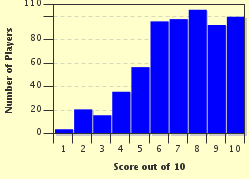Quiz Answer Key and Fun Facts
1. There is a greater proportion of alkene groups in the hydrocarbon chains of these molecules, which means restricted bond rotation, and a "kink" in the chain. As a result, the chains are unable to pack as closely together and so form fewer non-covalent interactions. The thermal energy provided by the temperature of the kitchen is therefore sufficient to overcome the interactions that do occur between these molecules.
2. Viral entities that have entered and manipulated the cell for their own replication induce the inflammatory response. This response involves the release of cytokines and histamine and it is this that makes you feel tired and achy. The body also produces lots of mucus to prevent entry of more external pathogens. This infection may spread via the lytic cycle, though cell lysis is not usually involved.
3. In such hypoxic conditions, pyruvate is unable to be oxidised to acetyl-coA, and is instead reduced to lactic acid. This acid decreases the pH in your muscle and thus causes you to "feel the burn".
4. Because UV-B can damage DNA by forming entities such as thymine dimers, melanogenesis is induced by melanocytes in the stratum basale. The melanin produced via the metabolism of the tyrosine in these cells is dark and so can absorb this harmful radiation which protects our DNA to an extent.
5. There are many different groupings, but the most important concerns the specific type of glycan chains that are present on the surface of erythrocytes. If neither an N-acetylgalactosamine or D-galactose is added to the standard H antigen, you may be described as a "universal donor".
6. This alkaloid binds to the dopamine transporter, therefore preventing the re-uptake of dopamine from the synaptic cleft into the pre-synaptic bulb. The resultant prolonged exposure of the post-synaptic membrane to dopamine leads to enhanced feelings of reward. However, sensitisation to this alkaloid leads to decreased dopamine responsiveness upon the alkaloid's withdrawal, leading to feelings of depression.
7. The main pigment in palisade cells has peak absorption spectra at around 465 and 665 nanometres, meaning it reflects light mainly in the region of 495-570 nanometres. If they were black they would be able to absorb all of the visible light, but this would be a waste of resources, since the inefficient photosynthetic enzymes could not cope with such an intake of energy.
8. It is more a predisposition that you inherit. Some people inherit genes which code for a faulty version of p53, which is no longer capable of initiating the correction of genetic mutations. Others inherit a faulty Rb protein which can no longer halt the cell cycle if damage occurs. Some people may even have a gene which overexpresses the Myc protein and so drives cells to proliferate too quickly.
9. After a period of rapid mitotic division of chondrocytes and endochondral ossification, the elevated levels of estrogen increase the rate of apoptosis among these chondrocytes. This leads to the depletion of the epiphyseal plate.
10. The physiological response here is largely regulated by adrenaline (epinephrine). There are many effects, such as a diversion of blood away from some organs and towards muscle. Additionally, adrenaline activates glycogen phosphorylase, which increases the amount of glucose in the bloodstream.
Source: Author
doublemm
This quiz was reviewed by FunTrivia editor
WesleyCrusher before going online.
Any errors found in FunTrivia content are routinely corrected through our feedback system.

